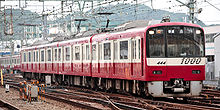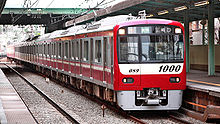- Keikyū N1000 series
-
Keikyū N1000 series 
Keikyū N1000 series number 1001, July 2007In service 2002 - Present Manufacturer Tokyu Car Corporation, Kawasaki Heavy Industries Number built 144 (as of March 2008) Formation 4/8 cars per set Operator Keikyū Specifications Car body construction Aluminium (batches 1-5),
stainless steel (batches 6 onward)Car length 18,000 mm Width 2,830 mm Maximum speed 120 km/h (service), 130 km/h (design) Electric system(s) 1,500 V DC overhead Gauge 1,435 mm (4 ft 8 1⁄2 in) The Keikyū N1000 series (京急新1000形) is a commuter electric multiple unit train type operated by Keihin Electric Express Railway (Keikyū) in Japan.[1]
Contents
Variants
Since the first set was introduced in March 2002, the type has undergone a number of design improvements. Sets built from 2002 to 2006 have painted aluminium bodies, whereas sets built from 2007 onward (set 1072 onward) have unpainted stainless steel bodies. More detailed variations are described below.
Batch 1
Delivered February to June 2002.
- 8-car sets x 3: 1001, 1009, 1017
- 4-car sets x 2: 1401, 1405
Fitted with single-arm pantographs and roller-blind destination indicators from new. Use Siemens GTO variable-frequency drive (VVVF).
Batch 2
 Set 1025 reliveried to commemorate the opening of Haneda Airport Terminal 2, March 2005
Set 1025 reliveried to commemorate the opening of Haneda Airport Terminal 2, March 2005
Delivered May to July 2003.
- 8-car sets x 2: 1025, 1033
- 4-car sets x 2: 1409, 1413
The centre pillars of the passenger windows were discontinued.
Batch 3
Delivered January to March 2005.
- 8-car sets x 2: 1041, 1049
- 4-car sets x 2: 1417, 1421
Feature IGBT variable-frequency drive.
Batch 4
Delivered July to August 2005.
- 8-car sets x 1: 1057
- 4-car sets x 4: 1425, 1429, 1433, 1437
Feature full-colour LED destination indicators.
Batch 5
Delivered November 2006.
- 8-car sets x 1: 1065
- 4-car sets x 2: 1441, 1445
No design changes over 4th batch vehicles.
Batch 6
Delivered March 2007.
- 8-car sets x 1: 1073
Use Mitsubishi inverters. Body design changed to unpainted stainless steel. The 4-seat transverse bays at the ends of cars were replaced by longitudinal bench seats.
Batch 7
Delivered January to February 2008.
- 8-car sets x 2: 1081, 1089
Yellow warning tape was added around the door interiors.
Batch 10
Delivered during fiscal 2010.[2]
- 8-car sets x 3: 1121, 1129, 1137
- 4-car set x 1: 1489
Audible warnings added for door opening/closing, and pairs of LCD passenger information screens installed above doors.[3]
References
- ^ Keikyū N1000 series. Retrieved on 17 September 2008. (Japanese)
- ^ 私鉄車両編成表 2011 [Private Railway Rolling Stock Formations - 2011]. Japan: JRR. July 2011. p. 42. ISBN 978-4-330-22711-5.
- ^ "京浜急行電鉄 新1000形10次車 [Keikyu N1000 series 10th-batch cars]". Japan Railfan Magazine (Japan: Kōyūsha Co., Ltd.) 50 (592): p.69. August 2010.
External links
Categories:- Electric multiple units of Japan
- Keihin Electric Express Railway
- 2002 introductions
Wikimedia Foundation. 2010.



